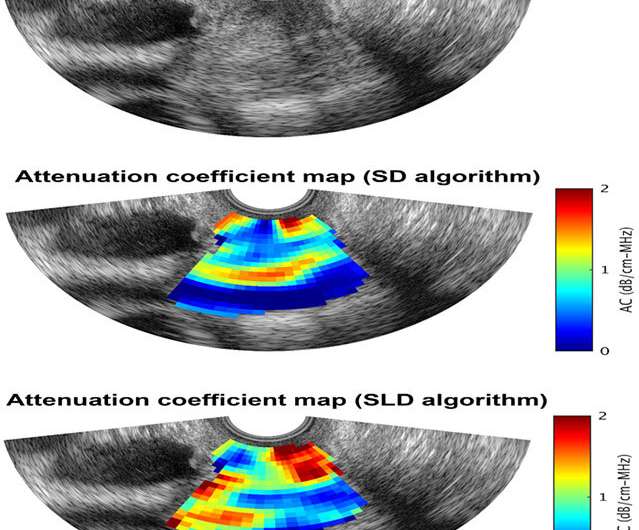An ultrasound B-mode image of the human cervix superimposed with a) anatomy labels, b) an attenuation coefficient map obtained using the spectral difference (SD) algorithm, and c) an attenuation coefficient map obtained using the spectral log difference (SLD) algorithm. Credit: Aiguo Han
Ultrasound can be used to examine cervix tissue and improve diagnostics, which is essential for predicting preterm births. Ultrasound data is used to compare two techniques for evaluating changes in cervical tissue throughout pregnancy.
Researchers at the University of Illinois at Chicago and the University of Illinois at Urbana-Champaign will discuss ultrasound techniques used during pregnancy at the 178th Meeting of the Acoustical Society of America, held at the Hotel Del Coronado in San Diego. "Comparison of two spectral-based techniques for estimating the attenuation coefficient from human cervix" is part of a session on biomedical acoustics and the application of quantitative ultrasound in humans.
Ziyang Xu, Aiguo Han, Douglas G. Simpson, W.D. O'Brien, Jr. and Barbara L. McFarlin are looking at ultrasonic attenuation coefficients that can help scientists characterize cervical changes throughout pregnancy and in preparation for birth before other symptoms, such as contractions or dilation, occur. Researchers compared two methods of finding the ultrasonic attenuation coefficient: the spectral difference and the spectral log difference techniques.
"Our research is based upon the biology of cervical changes in preparation for labor and childbirth, namely collagen remodeling. Ultrasonic attenuation is sensitive to these changes, as during pregnancy the collagen fibers are tightly packed and have a high attenuation," said McFarlin. "In preparation for labor and birth, there is increased collagen disorganization, increased water content and inflammation of the cervix, with low ultrasonic attenuation."
After gathering data on the two ultrasound techniques, the authors identified which performed better when it came to detecting cervical changes.
"This ASA presentation primarily evaluates the agreement in attenuation coefficient estimates between the two spectral-based techniques without referring to clinical outcomes. Future research is needed to evaluate the two techniques in terms of the ability to improve clinical diagnostics," said Han.
Han's presentation 2pBAb9, "Comparison of two spectral-based techniques for estimating the attenuation coefficient from human cervix," will be at 3:50 p.m. PT, Tuesday, Dec. 3, in the Garden room of the Hotel del Coronado in San Diego.
Provided by Acoustical Society of America



















